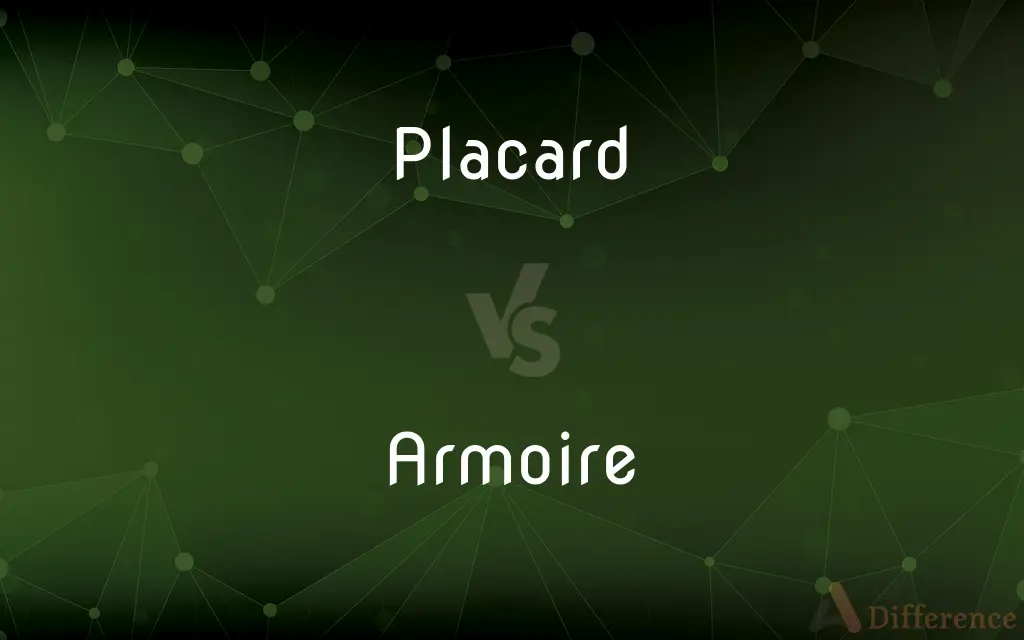Placard vs. Armoire — What's the Difference?
Edited by Tayyaba Rehman — By Urooj Arif — Updated on March 29, 2024
A placard is a poster or sign for public display, while an armoire is a large, often ornate cabinet or wardrobe for storing clothes or items.

Difference Between Placard and Armoire
Table of Contents
ADVERTISEMENT
Key Differences
A placard typically refers to a sign or notice displayed in a public space or carried in a demonstration or protest. It is designed to attract attention, convey messages, slogans, or advertisements, and is often made of paper, cardboard, or other lightweight materials. An armoire, in contrast, is a type of furniture that dates back to the 16th century, originally used to store arms and armor, evolving over time into a storage solution for clothing, linens, and, in modern uses, even electronics like televisions. Characterized by its tall structure, doors that swing open, and often, intricate designs or carvings, armoires are both functional and decorative elements in a room.
Placards are used for a variety of purposes, including political, commercial, informational, or as part of public demonstrations, showcasing their versatility in communication. Armoire are typically made from wood and can feature various styles, from antique to contemporary, reflecting the craft and design trends of different periods.
The primary difference between a placard and an armoire lies in their function and form. A placard is a temporary and portable form of communication, intended to be seen by as many people as possible, often in a dynamic or outdoor setting. An armoire, on the other hand, is a permanent piece of furniture that serves a specific storage purpose, offering a blend of functionality and aesthetic appeal within indoor environments.
While placards aim to convey messages or information quickly and effectively, often relying on bold text and visuals, armoires focus on utility and design, enhancing the décor of a space and providing organized storage. The production of placards involves simple materials and is generally cost-effective, aimed at broad distribution or display. Armoires, however, are crafted from more durable materials like wood and require a significant amount of craftsmanship, especially if they feature ornate designs or details.
Both placards and armoires have evolved over time to meet the changing needs and tastes of society. Modern placards utilize various technologies for printing and display, while contemporary armoires may incorporate features like built-in lighting or adjustable shelving, demonstrating how both items adapt to new roles and functionalities.
ADVERTISEMENT
Comparison Chart
Definition
A sign or poster for public display.
A large, often ornate, cabinet or wardrobe.
Purpose
To convey messages or advertisements publicly.
To store clothes, linens, or items.
Material
Paper, cardboard, or lightweight materials.
Wood, sometimes with metal or glass accents.
Location
Public spaces, demonstrations, or protests.
Homes, bedrooms, or living spaces.
Design
Simple with bold text and visuals.
Often ornate with detailed carvings or designs.
Durability
Temporary and portable.
Permanent and sturdy.
Functionality
Communication and information dissemination.
Storage with aesthetic and decorative appeal.
Evolution
Adapts with printing technologies and materials.
Incorporates modern features like lighting or adjustable shelving.
Compare with Definitions
Placard
A poster or sign for public display.
Protesters carried placards with slogans advocating for climate change action.
Armoire
Can be ornately designed with carvings or inlays.
The hand-carved armoire was a centerpiece of the living room decor.
Placard
Used in advertising and announcements.
A placard in the store window announced the upcoming sale.
Armoire
Originally used to store arms and armor.
The castle's armoire held an impressive collection of medieval weapons.
Placard
Can be handheld or mounted for visibility.
During the marathon, supporters held placards cheering on the runners.
Armoire
A tall, freestanding wardrobe or cabinet.
The antique armoire in the bedroom was used to store family heirlooms.
Placard
Often made of paper, cardboard, or similar materials.
The event organizers prepared colorful cardboard placards to guide attendees.
Armoire
Adapts to modern needs, storing electronics or as a pantry.
Their new armoire was designed to discreetly house the home entertainment system.
Placard
Designed to attract attention and convey a message.
The museum entrance displayed a large placard detailing the new exhibit.
Armoire
Features doors, shelves, and sometimes drawers.
The spacious armoire included shelves for linens and a drawer for valuables.
Placard
A placard is a notice installed in a public place, like a small card, sign, or plaque. It can be attached to or hung from a vehicle or building to indicate information about the vehicle operator or contents of a vehicle or building.
Armoire
A cupboard or wardrobe, typically one that is ornate or antique.
Placard
A sign or notice for display in a public place.
Armoire
A large, often ornate cabinet or wardrobe.
Placard
A small card or plaque, such as a nameplate on a door.
Armoire
A type of cupboard, cabinet, or wardrobe - originally used for storing weapons.
Placard
To announce or advertise by means of placards.
Armoire
A large wardrobe or cabinet; originally used for storing weapons
Placard
To post placards on or in.
Placard
To display as a placard.
Placard
A sheet of paper or cardboard with a written or printed announcement on one side for display in a public place.
Placard
(obsolete) A public proclamation; a manifesto or edict issued by authority.
Placard
(obsolete) Permission given by authority; a license.
To give a placard to do something
Placard
(historical) An extra plate on the lower part of the breastplate or backplate of armour.
Placard
(historical) A kind of stomacher, often adorned with jewels, worn in the fifteenth century and later.
Placard
The woodwork and frame of the door of a closet etc.
Placard
To affix a placard to.
Placard
To announce with placards.
To placard a sale
Placard
A public proclamation; a manifesto or edict issued by authority.
All placards or edicts are published in his name.
Placard
Permission given by authority; a license; as, to give a placard to do something.
Placard
A written or printed paper, as an advertisement or a declaration, posted, or to be posted, in a public place; a poster.
Placard
An extra plate on the lower part of the breastplate or backplate.
Placard
A kind of stomacher, often adorned with jewels, worn in the fifteenth century and later.
Placard
To post placards upon or within; as, to placard a wall, to placard the city.
Placard
To announce by placards; as, to placard a sale.
Placard
A sign posted in a public place as an advertisement;
A poster advertised the coming attractions
Placard
Post in a public place
Placard
Publicize or announce by placards
Common Curiosities
Can an armoire be used for purposes other than storage?
Yes, besides storage, armoires can also be decorative pieces in a room, and modern ones may even serve specific functions like housing electronics.
What makes placards effective in communication?
Their effectiveness lies in their visibility, simplicity, and the ability to convey messages quickly to a wide audience.
What is a placard?
A placard is a sign or notice intended for public display, often used in demonstrations or as advertisements.
What is the primary function of an armoire?
The primary function of an armoire is to serve as a storage unit for clothes, linens, or other items, often contributing to the room's decor.
How can an armoire enhance home decor?
An armoire can enhance home decor through its design, craftsmanship, and by serving as an elegant storage solution that complements the room's aesthetic.
How do placards differ from armoires in terms of material?
Placards are made from temporary materials like paper or cardboard, whereas armoires are constructed from durable materials like wood.
Are placards considered a form of art?
Yes, in many contexts, placards are considered a form of art, especially when they feature creative designs, illustrations, or are used in artistic protests.
How have armoires evolved to meet modern needs?
Armoires have evolved by incorporating features like built-in lighting, adjustable shelving, and designs that accommodate electronics, reflecting contemporary functionalities.
Is it common for armoires to be passed down as heirlooms?
Yes, due to their durability, craftsmanship, and often intricate designs, armoires are commonly passed down as family heirlooms.
What are some common places you might see a placard?
Placards are commonly seen at protests, outside businesses, at sporting events, or in public spaces for advertisements.
What are the considerations in choosing a placard for an event?
Considerations include the message's clarity, the placard's visibility, durability if used outdoors, and how effectively it conveys the intended message or theme.
What role do placards play in political demonstrations?
In political demonstrations, placards play a crucial role in conveying protestors' messages, slogans, and demands to the public and media.
How do modern and traditional armoires differ?
Modern armoires might incorporate minimalist designs, innovative storage solutions, and materials, while traditional ones focus on wood craftsmanship and ornate details.
Can placards be used indoors?
Yes, placards can be used indoors for events, exhibitions, or as informative signs in various settings.
How do you maintain an armoire?
Maintenance includes regular dusting, using appropriate wood cleaners, and ensuring the hinges and doors function smoothly to preserve its condition and appearance.
Share Your Discovery

Previous Comparison
Bactericidal vs. Bacteriostatic
Next Comparison
Along vs. TogetherAuthor Spotlight
Written by
Urooj ArifUrooj is a skilled content writer at Ask Difference, known for her exceptional ability to simplify complex topics into engaging and informative content. With a passion for research and a flair for clear, concise writing, she consistently delivers articles that resonate with our diverse audience.
Edited by
Tayyaba RehmanTayyaba Rehman is a distinguished writer, currently serving as a primary contributor to askdifference.com. As a researcher in semantics and etymology, Tayyaba's passion for the complexity of languages and their distinctions has found a perfect home on the platform. Tayyaba delves into the intricacies of language, distinguishing between commonly confused words and phrases, thereby providing clarity for readers worldwide.














































